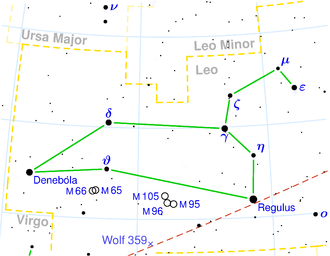NGC 3781
| Galaxy NGC 3781 |
|
|---|---|

|
|
| SDSS recording | |
| AladinLite | |
| Constellation | lion |
|
Position equinox : J2000.0 , epoch : J2000.0 |
|
| Right ascension | 11 h 39 m 03.7 s |
| declination | + 26 ° 21 ′ 42 ″ |
| Appearance | |
| Morphological type | S0 / a / Sy 2 |
| Brightness (visual) | 13.8 mag |
| Brightness (B-band) | 14.8 mag |
| Angular expansion | 0.5 ′ × 0.3 ′ |
| Position angle | 30 ° |
| Surface brightness | 11.6 mag / arcmin² |
| Physical data | |
| Redshift | 0.022676 +/- 0.000030 |
| Radial velocity | 6798 +/- 9 km / s |
|
Stroke distance v rad / H 0 |
(302 ± 21) · 10 6 ly (92.7 ± 6.5) Mpc |
| history | |
| discovery | Édouard Stephan |
| Discovery date | April 28, 1881 |
| Catalog names | |
| NGC 3781 • PGC 36104 • CGCG 157-005 • MCG + 05-28-004 • 2MASX J11390377 + 2621419 • GALEX ASC J113903.71 + 262141.5 • LEDA 36104 • LDCE 823 NED008 | |
NGC 3781 is a lenticular galaxy with an active nucleus of the Hubble type S0 in the constellation Leo on the ecliptic . It is estimated to be 402 million light years away from the Milky Way and has a diameter of around 45,000 ly.
In the same area of the sky are the galaxies NGC 3784 , NGC 3785 , NGC 3826 , among others .
The object was discovered on April 28, 1881 by Édouard Stephan .
